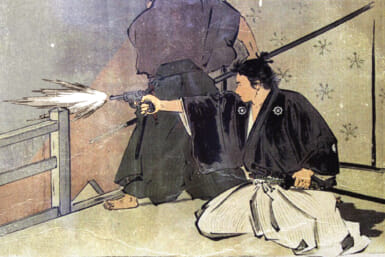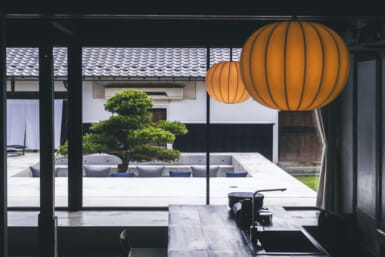by Yurie Horiguchi
The spring wedding season is just around the corner although traditionally, November and December are considered to be the “best” months for weddings.
One reason for the above is because October in Japan is said to be the “god-less” month when all the Shinto gods of the nation gather for a rest and play at the Great Shrine of Izumo and, as one of their pastimes, contrive marriages between suitable partners.
It must be great fun for the gods and goddesses to have an annual get-together and one wonders what they gossip about these days.
Have they mastered Japan’s new language, one wonders, with words such as gasorin, shokku, romansu, beisu appu (base up, meaning basic salary raise, believe it or not!), and, as I heard it on TV the other day, puragumachisumu, which translates into pragmatism —a word that not too many Occidentals themselves know the meaning of.
Maybe they have advanced Japanese language studies at the Great Shrine, and surely courses in modern trends and mannerisms, otherwise how could they keep au courant of what is going on in the land?
In all events, aside from being the site of the annual gods’ and goddesses’ convention, the Great Shrine at Izumo was originally erected in honor of Okuni-nushi-no-mikoto, the god of Love and Marriage, who seems to have been a sort of male Cinderella.
All his elder brothers “who were many,” fell in love with the same beautiful maiden named Yasaka-hime, and they all decided to vie for her hand in marriage.
His brothers laughed when young Okuni-nushi-no-mikoto said he wanted to go along too. But they finally allowed him to accompany them as their baggage carrier and servant. He went dressed in rags whereas his brothers wore their very finest.
You guessed it. The lovely princess chose Okuni-nushi-no-mikoto (what did she call him for short, I wonder?) who stood in a corner of the palace hall while his brothers tried to outdo each other in gushing prose.
As it happens so often today too, the princess liked his quality of silence and his looks. They married and lived happily ever after.
So it is that quite a few young people still visit the Izumo Great Shrine in the month of October to pray for a good marriage if they are betrothed, and for a good mate if they are single.
We hear so much about elaborate and extravagant wedding ceremonies and receptions these days that one forgets that marriage in Japan can really be a simpler ceremony than a registry marriage in the West.
All a young couple need do is to go to their local kuyakusho, or ward office, with two witnesses, fill in the marriage form, affix their respective seals, and the thing is done. The same applies for divorce by mutual consent (without witnesses), as I mentioned in an earlier column.
But the Shinto ceremony, together with the costume worn by the bride (usually rented) is something so memorable that many young people refuse to forego it. It is also a matter of “face” to invite as many important people as one can afford to the reception.
The Tokyo Shimbun recently reported that urban men and women today are getting married at about the same age—average 25 for men and 24 for women. There are very few teenage marriages, while 20 is the average for a farm bride.
In the old days (when I was young), before World War II, 18 to 20 was a good age for girls to marry, after they graduated from high school. Very few young maidens in those days went on to institutions of higher learning, unless they were truly intellectually so inclined, nor did they work.
Today, most young girls go to work in some capacity or another after graduating from highschool, while many others enter universities, although one often wonders to what purpose other than snaring an eligible youngster.
One of the reasons why maids are so scarce today, despite the high pay offered, is because there is no marriage potential in the job. For much less pay they prefer to work in a large office with plenty of single males around, where they generally perform the most menial tasks such as emptying ashtrays, serving tea. washing cups and running errands.
The traditional arranged marriage is also becoming a rarity, even in the highest social ranks. Crown Prince Akihito struck the first great blow against such marriages when he fell in love with a commoner industrialist’s daughter on the tennis-courts of Karuizawa and overrode all objections and age-old court tradition—to marry her.
Ninety percent of marriages in urban centers today are love marriages, although the approval of parents is sought in most cases, with the young people meeting in their mutual place of work, or continuing romances born on university campuses.
In the majority of “office” marriages, the young girl continues in her job for another couple of years or so, and if she is career minded and good at her job, her office will give her maternity leave when the time c0mes, and will take her back after a specified period.
Recently, the Mitsui Life Insurance Co. carried out a survey of 300 women employees to find out which qualities they placed highest in a husband-to-be: income, personality or good health.
Income, it seems, despite inflation and economic crises, is the least important quality (41%), while personality, meaning a reliable and considerate person, leads the list (91%) with good health a close runner-up (82%).
But another source gives us height, health, education and income, in that order. A statistician, someone once said, is a person who diligently collects facts and figures and from them draws any number of confusions.
But it is a fact that Japanese girls, whether short or tall themselves, prefer the men to be tall. As the average Japanese girl is 5 ft. 3, she wants her man to be at least 5′ 8″ and over, despite the old saying that “big men do not have enough intelligence for their whole body.”big men do not have enough intelligence for their whole body.








